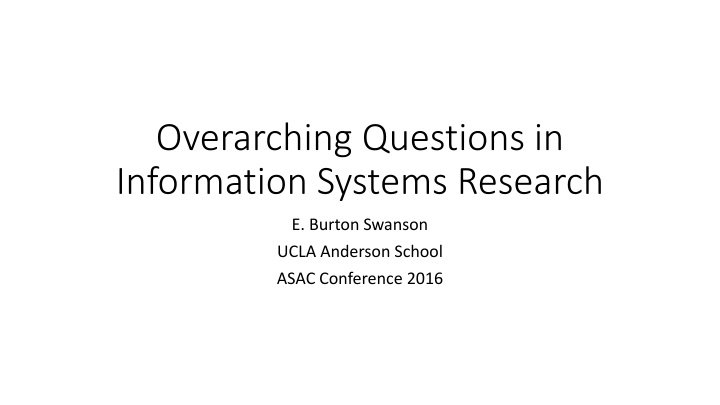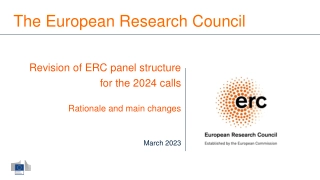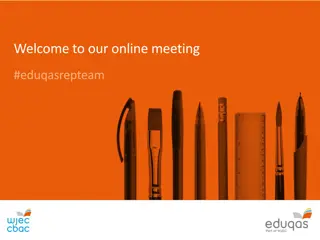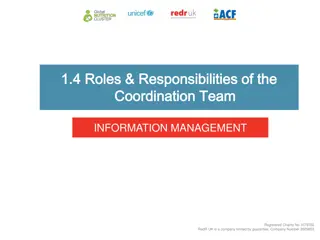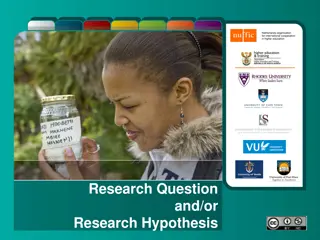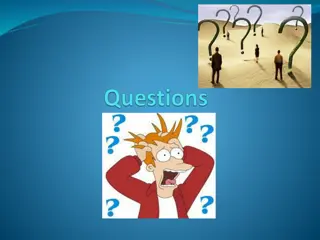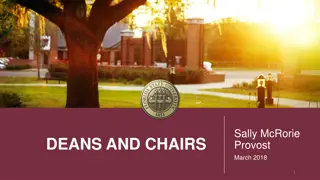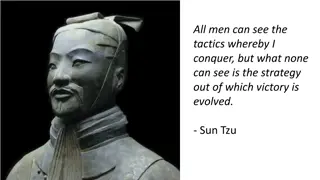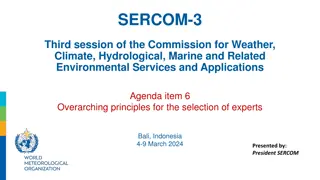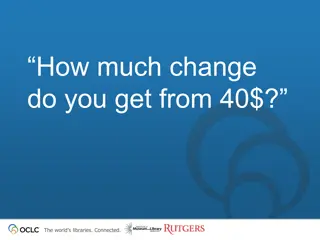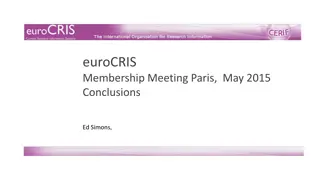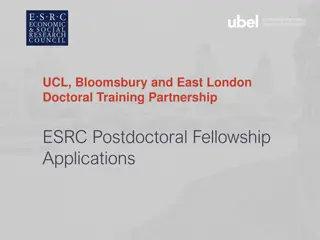Importance of Overarching Questions in Information Systems Research
Explore the significance of overarching questions in information systems research, their role in motivating research studies, tying together separate studies, summarizing work, and focusing the efforts of research centers. Understand the criteria for crafting effective overarching questions and how they can provide motivation and direction in the field of information systems research.
Download Presentation

Please find below an Image/Link to download the presentation.
The content on the website is provided AS IS for your information and personal use only. It may not be sold, licensed, or shared on other websites without obtaining consent from the author.If you encounter any issues during the download, it is possible that the publisher has removed the file from their server.
You are allowed to download the files provided on this website for personal or commercial use, subject to the condition that they are used lawfully. All files are the property of their respective owners.
The content on the website is provided AS IS for your information and personal use only. It may not be sold, licensed, or shared on other websites without obtaining consent from the author.
E N D
Presentation Transcript
Overarching Questions in Information Systems Research E. Burton Swanson UCLA Anderson School ASAC Conference 2016
Exercise! Consider your current most important research study. What question does this study attempt to answer? What overarching question motivates the body of research of which the study is one part? Send your overarching question to: burt.swanson@anderson.ucla.edu
The overarching question Motivates a body of research (a set of studies undertaken over time by an individual, group, organization, or field, where any one study is informed by the findings of earlier ones, such that progress is made) Not always articulated in the research publications! Important or not?
Importance of overarching questions Provide motivation for a single study Useful in tying separate studies together Helpful in summarizing your own work Can focus the work of a research center Can speak to significance of a field s endeavors
My own research Q1: Why are information systems used or not? Q2: Why do information systems require so much maintenance? Q3: Why do some information systems innovations diffuse widely, while others do not? Really interesting questions, o.k., maybe not to everyone
Question forms What How Why Can Which Should Many forms. Which does yours take? Why-questions lend themselves to theorizing
Overarching question criteria Should be readily understandable by a wide audience. Should have implications for practice. Should be interesting. Should be answerable at least in part by a program of research.
Overarching Q1 Why are information systems used or not? Early MIS which provided for online database inquiry from terminals often went unused by managers. I undertook a study of one such system. Conjecture was that appreciation of the system founded in a priori involvement in its development would lead to its use. Supported by the study. (Swanson, 1974) Other studies followed.
Overarching Q2 Why do information systems require so much maintenance? Many IS departments reported that more than half their staff was allocated to maintenance, rather than new system development. I undertook (with Ben Lientz) a survey study designed to explore why. A finding was that maintenance typically included substantial informal enhancement. Maintenance was perfective, not just corrective or adaptive. (Lientz and Swanson, 1980) Other studies followed.
Overarching Q3 Why do some IS innovations diffuse widely while others do not? IS practice seemed to always chase the Next Big Thing. Managerial attention was often intense, but fleeting. While some IS innovations diffused widely, others failed to catch on and did not. Innovation theory was relatively well developed, but not yet particularized to IS. It also did not explain well different diffusion outcomes. I undertook to develop some IS-specific theory.
Follow the buzzwords! Why so many in the world of IT? Is there substance here or just so much noise? Web services! ERP! Knowledge management! CRM! Business intelligence!
Making sense of the buzz Ref: Ramiller, 2001 they jumped into it, because it was the latest and the greatest craze at the time and they figured they had to sign up for it, too and, We ve got to go in and we ve got to do what everybody else is doing, -Consultant and I keep waiting for a silver bullet, a magic formula, an answer to all my prayers, and it never happens! -IS manager In today s business world you really have to grab right at the money. Profit before taxes, cash, cost reduction. We re gonna take a building and close it, because of this technology. We re gonna reduce our administrative staff. I mean, hard core numbers. -IS manager I think [data warehouse] is a well-worn concept, and I think a whole lot a people thought it was a good idea 30 years ago. So, yeah it s a 30-year-old concept with a different name. It s sort of a rose by any other name. -IS manager you see if it has meaning, you know, as you understand it. Would it help your organization, would it help certain areas of your organization, where might it help, what are the benefits of it? you really need to drill down, in terms of what these concepts are, and what it means from an implementer s point of view, and what it can mean to your business. -IS manager
Conjecture Buzzwords are important to understanding much IS innovation. They serve to call attention to the idea of the innovation. Recall that an innovation is defined as an idea, practice, or object new to the organization adopting it The idea of the innovation is central to its adoption, implementation, and diffusion But it is problematic!
Organizing vision Ref: Swanson and Ramiller, 1997 A focal community idea for applying new IT in firms Typically identified by a buzzword Defines the innovation in broad strokes and is the basis for its comprehension Produced by and sustained through the community s talk about it (e.g. at trade shows and in trade press) Provides for interpretation (what is it?), legitimation (why do it?), and mobilization of entrepreneurial and market forces (in providing requisite products and services) Drives and is driven by the innovation s adoption and diffusion Has a characteristic career (in terms of its visibility, prominence, and influence over time) Illustration: Enterprise Resource Planning (ERP) in the 1990s, as first articulated by the Gartner Group
ERPs career Ref: Swanson, 2003 Recent events in hardware, operating systems and applications are crystalizing (sic) our definition of Enterprise Resource Planning systems-- the Next- Generation MRP II. (Wylie, 1990) What s all the buzz about? Simply put, R/3 seems to be a case of the right product at the right time. (Xenakis, CFO, 1996) Here comes SAP! (Fortune, 1995) The growing number of horror stories about failed or out-of-control projects should certainly give managers pause. (Davenport, HBR, 1998) As 1999 winds down, it seems ironic that enterprise resource planning (ERP) has again attained almost the same dubious status it had when the acronym entered the lexicon in 1990- that of an idea that would never work. (Keller, Manufacturing Systems, 1999) (I)t becomes clear the enterprise resource planning strategies were really designed to get the corporate house in order. (Connolly, Computerworld, 1999)
Gartners hype cycles Ref: Nelson, 2001 CRM at the height of inflated expectations, with disillusionment soon to set in
The wave complex Ref: Swanson, 2012 A myriad of opportunities to study and better understand IT innovation diffusion, e.g., regarding globality, does geography matter? Cumulative attention (to organizing vision) Cumulative adoptions Cumulative implementations Cumulative value added t* t** t*** time >
Five studies Q3.1 Q3.2 Q3.3 Q3.4 Q3.5 How is an organizing vision received? How is a career launched? How is momentum sustained? How is value achieved? How is widespread attention gained and held?
Innovation comprehension Ref: Ramiller and Swanson, 2003 How is an organizing vision received? Study (1994-96) combined field interviews with survey (143 respondents) sample item: The company that waits to do X is going to fall dangerously behind. (agree-disagree) 45 items Examined reception of three visions in different stages of their careers: E-commerce (early ascent) Client server (late ascent) CASE (descent) Identified the dimensions of reception: Interpretability Plausibility Importance (business benefits, practical acceptance, community interest) Discontinuity A finding: To the extent an organizing vision is ascendant (in discourse), it is received as important
How is a career launched? Ref: Wang and Swanson, 2007 How is early momentum toward wide adoption achieved? Conjecture: institutional entrepreneurship plays crucial role Self-interested actors leverage resources to create new institutions or to transform existing ones Mobilization and legitimation activities are undertaken Case study: Professional Services Automation (PSA) Enterprise software purported to help service-oriented organizations manage their projects and employees, 1998- Actors included IT research firms, software vendors, consultancies, conference firms, trade publications, and universities Findings: institutional entrepreneurs are challenged to: Develop and recognize leadership in the innovation s organizational community. Facilitate or persuade community members to focus their attention on the innovation. Develop a coherent organizing vision for the innovation. Incorporate definitive success stories from users and vendors into the organizing vision for the innovation. Alas, this was not accomplished in the case of PSA
Bandwagon building Adoption dynamics Rate of adoption rises, then falls Extent of adoption among potential adopters is uncertain Important for network effects Rapidity of adoption is also uncertain Important for drawing attention to the innovation Bandwagon can be created where innovation becomes a management fashion
How is momentum sustained? Ref: Wang and Swanson, 2008 Momentum in adoption allows bandwagon participants to ride and exploit it Consultancies are drawn in, in particular to help with implementation, lessons are promulgated Case study: Business Week s special advertising sections on CRM (nine published, 2000-2004) Findings: Participants acted to both exploit and extend CRM s momentum Serialized content Accentuated evolution and progress of CRM Identified promising new developments to keep CRM vision fresh and responsive
Assimilation How is value achieved? Research suggests that upon implementation of new IT, firm performance may initially suffer (see, e.g., Ross, 1998) Firms must learn how to use new IT Training is important, but does not suffice Situated learning by doing is required Workers must learn how to use new IT not only individually, but also collectively With experience, firms are able to assimilate new IT into reconstructed work practices and organizational routines such that new capabilities are achieved Yamauchi and Swanson (2010) studies one firm s problematic assimilation of CRM across multiple locations, finding that routines are built by means of familiarity pockets outside of which system functionality can be ignored
Wikipedia study Ref: Gorgeon and Swanson (2013) How is widespread attention gained and held? Five-year history of Web 2.0 entry in Wikipedia Reveals the capture of an organizing vision Wikipedia as a new encyclopedic form Web 2.0 Expo Expo Web 2.0 Web 2.0 Web 2.0 Summit Summit Web 2.0 Summit Summit Web 2.0 Web 2.0 Web 2.0 Expo Expo Web 2.0, millionth English word? English word? Web 2.0, millionth Times = YOU YOU Times = Berners-Lee dismisses Web 2.0 Web 2.0 Berners-Lee dismisses Web 2.0 Web 2.0 Summit Summit Web 2.0 Summit Summit Web 2.0 Web 2.0 Web 2.0 Expo Expo Web 2.0 Trademark contreversy contreversy Web 2.0 Trademark Web 2.0 Web 2.0 Expo Expo Google search trend Wikipedia Web 2.0 page popularity 2nd Web 2.0 Conference Conference 2nd Web 2.0 What is Web 2.0? 1st Web 2.0 1st Web 2.0 Conference Conference Articles with Web 2.0 in body text Articles with Web 2.0 title -4 -2 0 2 4 6 8 10 12 14 16 18 20 22 24 26 28 30 32 34 36 38 40 42 44 46 48 50 52 54 56 58 Dec. 07 Dec. 06 Dec. 05 Dec. 07 Dec. 06 Dec. 05 Dec. 08 Dec. 08 Dec. 09 Dec. 09 Number of months since first entry
Summing up How is the organizing vision concept useful? Provides a theoretical lens for answering Q3: Why do some information systems innovations diffuse widely, while others do not? Offers a broad perspective within which to position both new and familiar research on adoption, implementation, and use. Enables the development of a historical perspective in the information systems field.
Overarching questions revisited A reminder: have you sent me yours? Are we persuaded that such questions can be useful? Any questions about overarching questions?
Added thoughts Overarching questions Can be imputed after the fact, and may also be disputed Are not necessarily specific to a field May be enduring or not Can characterize research as a practice
Lastly Imagine that you have just encountered your Dean in the elevator. He or she asks you, What s with your research? What question are you trying to answer with it? Are you now prepared for this? I hope so! Thanks for the invitation to join you in Edmonton!
